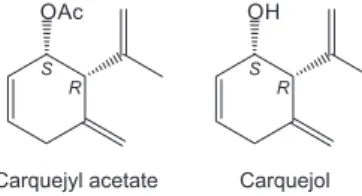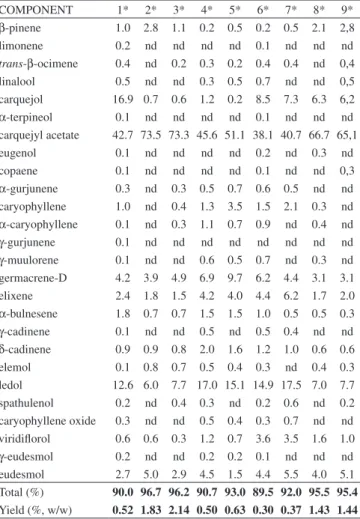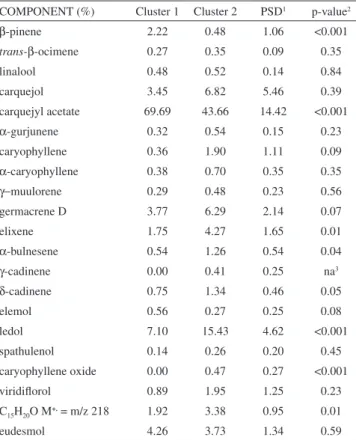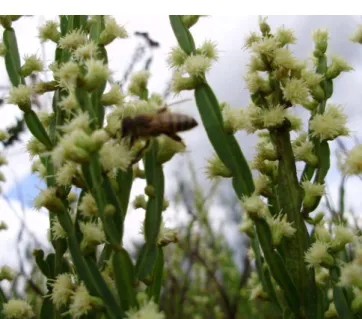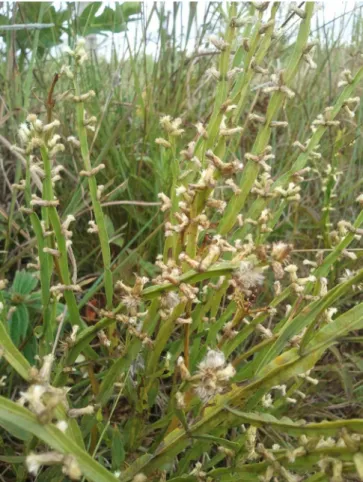Artigo
*e-mail: dsnunes@pq.cnpq.br
CHEMICAL COMPOSITION OF VOLATILES FROM MALE AND FEMALE SPECIMENS OF Baccharis trimera COLLECTED IN TWO DISTANT REGIONS OF SOUTHERN BRAZIL: A COMPARATIVE STUDY USING CHEMOMETRICS
Michele Aparecida Besten and Domingos Sávio Nunes*
Departamento de Química, Universidade Estadual de Ponta Grossa, Av. Carlos Cavalcanti 4748, 84030-900 Ponta Grossa – PR, Brasil Alberto Wisniewski Jr.
Departamento de Química, Universidade Federal de Sergipe, Rod. Mal. Rondon S/N, 49100-000 São Cristóvão – SE, Brasil Sávio Luis Sens
Centro de Educação Tecnológica Irmão Mário Cristóvão (TECPUC), Rua Imaculada Conceição 1155, 80215-901 Curitiba – PR, Brasil
Daniel Granato
Núcleo de Análise e Tratamento de Dados, Instituto Adolfo Lutz, Av. Dr. Arnaldo 355, 01246-902 São Paulo – SP, Brasil Edésio Luis Simionatto, Dilamara Riva Scharf and Juliana Bastos Dalmarco
Laboratório de Cromatografia, Fundação Universidade Regional de Blumenau, Rua São Paulo 3250, 89030-000 Blumenau – SC, Brasil
Nelson Ivo Matzenbacher
Departamento de Botânica, Universidade Federal do Rio Grande do Sul, Av. Bento Gonçalves 9500, Bl. 4, Prédio 43433, 91540-000 Porto Alegre – RS, Brasil
Recebido em 25/10/12; aceito em 5/5/13; publicado na web em 17/7/13
GC/MS/FID analyses of volatile compounds from cladodes and inflorescences from male and female specimens of Baccharis trimera (Less.) DC. collected in the states of Paraná and Santa Catarina, Brazil, showed that carquejyl acetate was the primary volatile component (38% to 73%), while carquejol and ledol were identified in lower concentrations. Data were subjected to hierarchical cluster analysis and principal component analysis, which confirmed that the chemical compositions of all samples were similar. The results presented here highlight the occurrence of the same chemotype of B. trimera in three southern states of Brazil.
Keywords: Baccharis trimera; carqueja; carquejyl acetate.
INTRODUCTION
The section Caulopterae from the genus Baccharis is composed of plants that can look very similar to each other, making it difficult to differentiate them1 both in the field and based on their herbarium
material. These plants are known as carquejas and they present with ribbed or winged stems (cladodes),2 and therefore can be recognized
as a section by this distinguishing characteristic.3
Baccharis trimera (Less.) DC., Caulopterae (popularly known as carqueja), despite being widely studied,4,5 is hardly distinguishable
from some other species in the same section;6 this represents a hurdle
in maintaining the quality control of pharmaceutical products made from this plant. This is the only species of the genus that is contai-ned in the first and fourth editions of the Brazilian Pharmacopoeia,7
representing its importance.8 Carqueja is traditionally used by the
Brazilian population due to its analgesic and diuretic properties, to facilitate digestion, to diminish stomach aches, and to control hypertension and diabetes.9
A recent study reported interesting field observations and detailed morphological differences among several Caulopterae species that occur in the state of Rio Grande do Sul, Brazil.10 As for taxonomic
identification, B. trimera (Less.) DC. has been considered a synonym for Baccharis crispa Spreng., in spite of the differences that can be observed in plant populations occurring in natura, especially phenological differences. For example, flowers and fruits from B. trimera bloom from January to March, and their maximum production
occurs in February, while B. crispa flowers and fruits do so between February and April, and their maximum production occurs in March. Another important factor to note is that bovine animals do not con-sume B. trimera even when available in large natural formations and when their pasture area is limited, while other species of the section Caulopterae, like B. crispa, Baccharis articulata (Lam.) Pers. and Baccharis stenocephala Baker, are avidly consumed.
To compare the compositions of essential oils from several species of the Caulopterae section collected in Rio Grande do Sul, Brazil and Argentina, B. articulata, B. crispa, Baccharis milleflora (Less.) DC., Baccharis myriocephala DC., B. stenocephala Baker, Baccharis junciformis DC. (also known as Baccharis usterii Hering) and B. trimera were investigated and carquejyl acetate was identified only in the essential oil from B. trimera.11 A high proportion of this compound
has also been found in the essential oil from B. trimera collected in the same Brazilian region during a study of volatile compounds obtained by supercritical CO2 extraction.
12 Carquejyl acetate was occasionally
found in samples collected in areas of Cerrado (Mogi Guaçu) and in the Atlantic Forest (Santo André), both of which are in the state of São Paulo.13 However, carquejol and carquejyl acetate (Figure 1)
were not found when several other samples from the southeastern region of Brazil were analyzed.5,14
two distant locations and analyzing the chemical similarities among samples by utilizing a chemometric approach.
EXPERIMENTAL
Collection, identification and preparation of plant material
Male and female specimens of Baccharis trimera (Less.) DC. were collected in Segundo Planalto of Paraná in the state of Paraná, Brazil on February 1st of 2011 at the borders of road PR-513 in the
geographical position 25°08’20’’ South by 49º59’56’’ West at an altitude of 1,061 meters; specimens were also collected on January 18th of 2011 in Alto Vale do Rio Itajaí, Rio do Sul, Santa Catarina,
Brazil in the geographical position 27º16’00’’ South by 49º36’00’’ West at an altitude of 530 meters. The botanical exsiccates were deposited at the Federal University of Rio Grande do Sul (UFRGS) Herbarium as ICN 174976 and ICN 174977. The male and female specimens from each region were collected at the same place, date and time. The samples used to assess the chemical composition were dried at room temperature for two days and the impurities were care-fully separated to yield up to 100 g of inflorescences and cladodes of each plant species. The plant materials were stored in airtight jars in a freezer at −18 °C until the extraction procedure. Table 1 summarizes the data of all materials tested.
Isolation and analysis of volatiles
Approximately 100 g of male and female inflorescences or clad-odes were ground separately and hydrodistilled for 3 h in a 2 L flask containing 1 L of distilled water. The flask was attached to a glass apparatus built according to a recommended design.15 The
hydro-distilled volatiles were collected in ethyl ether, the remaining water was decanted and the solvent was evaporated at room temperature. The yields of the oils were calculated taking into consideration the initial plant material mass.
The volatiles were analyzed using a Varian® CP-3800 gas
chromatograph with Saturn® GC/MS Workstation 5.51 software; the gas chromatograph was operated in EI mode at 70 eV with a mass scan range of 40–650 m/z at a sample rate of 1.0 scan s−1; a 30 m
long CP-Sil-8 CB LowBleed/MS capillary column with a 0.25 mm diameter and a 0.25 µm film was used. The temperature of the injector was maintained at 250 °C and the temperature of the interface was held at 240 ºC. A flow rate of 5 mL min−1 was utilized and helium
was the carrier gas. The injection volume was 1.0 µL of oil (diluted in ethyl ether). The temperature was programmed to increase in ac-cordance with the following conditions: 50 °C for the first minute, increase by 3 °C min–1 up to 240 °C, and the split ratio was set to
1/50. The relative retention indices were calculated using data from a series of n-alkanes (C10–C30) under the same conditions used for the volatile compounds. To validate the system and ensure the reliability of the calculated retention indexes, standards of α-pinene, β-pinene, limonene, linalool, caryophyllene, spathulenol and viridiflorol were used. The relative composition of each oil sample was measured on a Shimadzu 14B gas chromatograph with a flame ionization detector (GC/FID) and a OV-5 column (30 m x 0.25 mm x 0.25 µm). Nitrogen was used as the carrier gas with a constant pressure of 80 kPa, a split ratio of 1/150 was used and the oil injection volume (diluted in ethyl ether) was 1 µL. The temperatures of the detector and the injector were kept at 300 and 250 °C, respectively. The initial temperature in the column was 50 °C (for 3 min), with a heating rate of 5 °C min−1
until the temperature reached 270 °C, then the temperature was held constant for 8 min.16
Application of chemometrics
To assess associations between all the chemical compounds and highlight both chemical similarities and differences among B. trimera samples, pattern recognition methods were applied to the experimen-tal data, namely principal component analysis (PCA) and hierarchical cluster analysis (HCA), which are unsupervised statistical methods. PCA was applied to auto scaled data to describe the relationship between the samples; this method also checks to see if the data are similar or dissimilar and if the data represents typical data or outliers. The loading vectors describe the importance of each variable. PCA was applied to separate the samples (n=9) according to their chemical markers (n=27), totaling 243 data points. To organize the data for PCA, the chemical compound results were put into columns and the B. trimera samples were put into rows. Analyses were based on corre-lations and variances were calculated as SS/(n-1). Eigenvalues higher than 1.0 were adopted to explain the projection of the plant samples on the factor-plane (PC 1 vs PC 2), following the Kaiser criterium.17
HCA displays the data in a way that emphasizes natural clusters and patterns in a two-dimensional space. HCA was applied to auto scaled data using a one-step approach; the Ward’s method was used as an amalgam rule and the Euclidean distances and metrics were used to generate a dendrogram of all samples.18 Comparison between
the two suggested clusters was performed by the Student’s t-test for independent samples after checking the homogeneity of variances using the F-test.
RESULTS AND DISCUSSION
The chemical constituents of the volatile compounds from all botanical materials analyzed in this study are shown in Table 2. The monoterpenes class was the main chemical class in all samples, and this was due to the amount of carquejyl acetate present in the samples. The analyses presented here are the first reported in the literature that compare volatile compounds from male and female specimens of B. trimera collected in Southern Brazil. The chemical profile found in
Figure 1. Chemical structures of carquejyl acetate, the main volatile
compo-nent of Baccharis trimera, and its related alcohol carquejol
Table 1. Information for all collections of B. trimera botanical materials
COLLECTION DAY I C S Codes*
18/01/2011 x BMCSC
18/01/2011 x BFCSC
18/01/2011 x BMISC
18/01/2011 x BFISC
03/01/2011 x SHOOTS
01/02/2011 x BMCPR
01/02/2011 x BFCPR
01/02/2011 x BMIPR
01/02/2011 x BFIPR
the present study was similar to that of essential oils from botanical materials from the state of Rio Grande do Sul, in which carquejyl acetate is represented in high proportions (40.7 to 73.5%) and two other characteristic components represented lower proportions in all samples: ledol (6.0 to 17.5%) and carquejol (0.2 to 8.5%).11
The yields for each volatile oil are shown in the last line of Table 2, where it is observed that the highest yield was obtained for oils extracted from samples collected in Paraná. The yields of volatile compounds from cladodes of B. trimera were about 1% to 2%, con-firming the high yields found in the literature.11 An opposite behavior
was observed for inflorescences (0.3%–0.5% yield). Another impor-tant observation was that oils obtained from male specimens virtually always presented higher yields as compared to female specimens.
The analyses also indicated that carquejyl acetate was found in higher proportions in cladodes, whereas ledol and carquejol are more prominent in the inflorescences. The volatile oils from buds presented a higher concentration of carquejol (17.0%) as compared to all other samples.
PCA (Figure 2) showed that the first three components explained up to 83% of the variability in the data, and the projections of the B. trimera samples were clearly separated into two distinct groups: Group 1 comprised BFCPR, BMCSC, BMCSC, and BMCPR, whe-reas Group 2 comprised BMIPR, SHOOTS, BFISC, BMISC, and
BFIPR. This initial separation was further confirmed using HCA for the samples (Figure 3). Figure 2B shows the factor analysis using the response variables tested in this study, that is, which variables were responsible for the projection of samples in the factor plane (PC 1 x PC 2). In summary (Table 3), by examining the scatterplot (PC 1 x PC 2) obtained by PCA and the dendrogram for samples obtained by HCA, it is observed that the first group consists of samples of volatiles extracted from cladodes, whereas the volatile compounds contained in Group 2 were obtained from shoots or inflorescences (shoots). By using these chemometric tools, it was possible to compare the degree of similarity among samples and variables simultaneously, which is a great advantage compared to univariate methods, such as analysis of variances (ANOVA).
Indeed, cluster analysis is an exploratory data analysis tool which aims to sort different samples into groups in a way that the degree of association between two samples is maximal if they belong to the same group and minimal otherwise. Even though these multivariate methods were successfully applied in the current work, these results are only indications of grouping patterns due to the limited number of samples analyzed.
Thus, it is possible to assume that each group will have similar chemical compositions. All these data indicate there are no significant differences between the chemical compositions of samples coming from the states of Paraná and Santa Catarina and the strongest factor to discriminate the oils seems to be the plant organ.
The results presented here confirm a recent report that stated that significant differences between the chemical compositions of the volatile metabolites from male and female specimens of the Baccharis species can be minimized by collecting botanical materials in the same place and time.16
The observed variation in the chemical compositions of essential Table 3. Correlation between the original variables and the first three prin-cipal components
COMPONENT PC1 PC2 PC3
β-pinene -0.92 -0.14 -0.05
trans-β-ocimene 0.66 -0.41 -0.45
linalool 0.50 0.19 -0.62
carquejol 0.16 -0.51 -0.80
carquejyl acetate -0.93 0.21 0.27
α-gurjunene 0.92 0.25 0.02
caryophyllene 0.80 0.25 0.01
α- caryophyllene 0.60 0.59 0.16
γ-muulorene 0.66 0.50 0.02
germacrene D 0.67 0.67 0.11
elixene 0.89 -0.30 0.27
α-bulnesene 0.55 0.54 -0.44
γ-cadinene 0.80 -0.29 0.24
δ-cadinene 0.72 0.49 0.31
elemol -0.58 0.62 0.41
ledol 0.98 -0.07 0.05
spathulenol 0.40 -0.65 0.31
caryophyllene oxide 0.92 -0.20 0.08
viridiflorol 0.57 -0.59 0.20
C15H20O M+. = 218 0.91 -0.27 0.27
eudesmol -0.11 -0.71 0.44
Eigenvalue 10.85 4.18 2.33
Cumulative explained variance (%)
51.68 71.58 82.67
Note: Factor loadings higher than 0.50 are highlighted. Table 2. Yields and relative compositions (%) of the volatiles from the
cla-dodes and inflorescences of male and female specimens of Baccharis trimera collected in Paraná and Santa Catarina
COMPONENT 1* 2* 3* 4* 5* 6* 7* 8* 9*
β-pinene 1.0 2.8 1.1 0.2 0.5 0.2 0.5 2.1 2,8 limonene 0.2 nd nd nd nd 0.1 nd nd nd trans-β-ocimene 0.4 nd 0.2 0.3 0.2 0.4 0.4 nd 0,4 linalool 0.5 nd nd 0.3 0.5 0.7 nd nd 0,5 carquejol 16.9 0.7 0.6 1.2 0.2 8.5 7.3 6.3 6,2
α-terpineol 0.1 nd nd nd nd 0.1 nd nd nd carquejyl acetate 42.7 73.5 73.3 45.6 51.1 38.1 40.7 66.7 65,1 eugenol 0.1 nd nd nd nd 0.2 nd 0.3 nd copaene 0.1 nd nd nd nd 0.1 nd nd 0,3
α-gurjunene 0.3 nd 0.3 0.5 0.7 0.6 0.5 nd nd caryophyllene 1.0 nd 0.4 1.3 3.5 1.5 2.1 0.3 nd
α-caryophyllene 0.1 nd 0.3 1.1 0.7 0.9 nd 0.4 nd
γ-gurjunene 0.1 nd nd nd nd nd nd nd nd
γ-muulorene 0.1 nd nd 0.6 0.5 0.7 nd 0.3 nd germacrene-D 4.2 3.9 4.9 6.9 9.7 6.2 4.4 3.1 3.1 elixene 2.4 1.8 1.5 4.2 4.0 4.4 6.2 1.7 2.0
α-bulnesene 1.8 0.7 0.7 1.5 1.5 1.0 0.5 0.5 0.3
γ-cadinene 0.1 nd nd 0.5 nd 0.5 0.4 nd nd
δ-cadinene 0.9 0.9 0.8 2.0 1.6 1.2 1.0 0.6 0.6 elemol 0.1 0.8 0.7 0.5 0.4 0.3 nd 0.4 0.3 ledol 12.6 6.0 7.7 17.0 15.1 14.9 17.5 7.0 7.7 spathulenol 0.2 nd 0.4 0.3 nd 0.2 0.6 nd 0.2 caryophyllene oxide 0.3 nd nd 0.5 0.4 0.3 0.7 nd nd viridiflorol 0.6 0.6 0.3 1.2 0.7 3.6 3.5 1.6 1.0
oils obtained from various samples of B. trimera, as published in the literature, can be used to organize the known samples into three groups. Firstly, carquejyl acetate is the main component in some cases with carquejol and ledol in minor proportions;11 this is in contrast to a
second group of samples which have higher proportions of carquejol
in comparison with carquejyl acetate and no ledol;13 and in the third
group there is a total absence of these componentes.5,14 This division
suggests the existence of three chemotypes of the plant species B. trimera based on the proportions of carquejol, carquejyl acetate and ledol. This critical analysis points to the urgent need for a review of the botanical occurrences of this plant species in Southern and Southeast Brazil, since this species is widely commercialized and industrialized. Once the groups were characterized using HCA, the averages of the chemical compounds were compared by the Student t-test for independent samples after checking for the homogeneity of variances by the F-test (Table 4); it was observed that the β-pinene, carquejyl acetate, elixene, α-bulnesene, ledol, caryophyllene oxide and the unidentified C15H20O M
+. = m/z 218 contents were statistically
dif-ferent (p <0.05) between the 2 clusters. Thus, it can be inferred that the concentrations of these compounds were primarily responsible for the differentiation of samples included in the two groups. In the same sense, the contents of caryophyllene, germacene D, δ-cadinene and elemol seemed to be marginally different between the clusters, show-ing the usefulness of these compounds to serve as chemical markers for differentiating samples of volatile compounds in this study.
CONCLUSIONS
Differing from what was previously found,5 the results presented
and discussed here suggested great similarity between the composi-tions of volatile compounds from male and female specimens of B. trimera, both from cladodes and inflorescences collected in distant regions of southern states of Brazil.
All samples analyzed in this study presented considerable con-centrations of carquejol, carquejyl acetate and ledol in two different organs of male and female plants. This is an interesting result because the studied plant samples were collected in different regions, as well Table 4. Comparison between the two formed clusters
COMPONENT (%) Cluster 1 Cluster 2 PSD1 p-value2
β-pinene 2.22 0.48 1.06 <0.001
trans-β-ocimene 0.27 0.35 0.09 0.35
linalool 0.48 0.52 0.14 0.84
carquejol 3.45 6.82 5.46 0.39
carquejyl acetate 69.69 43.66 14.42 <0.001
α-gurjunene 0.32 0.54 0.15 0.23 caryophyllene 0.36 1.90 1.11 0.09
α-caryophyllene 0.38 0.70 0.35 0.35
γ−muulorene 0.29 0.48 0.23 0.56
germacrene D 3.77 6.29 2.14 0.07
elixene 1.75 4.27 1.65 0.01
α-bulnesene 0.54 1.26 0.54 0.04
γ-cadinene 0.00 0.41 0.25 na3
δ-cadinene 0.75 1.34 0.46 0.05
elemol 0.56 0.27 0.25 0.08
ledol 7.10 15.43 4.62 <0.001
spathulenol 0.14 0.26 0.20 0.45
caryophyllene oxide 0.00 0.47 0.27 <0.001
viridiflorol 0.89 1.95 1.25 0.23
C15H20O M+. = m/z 218 1.92 3.38 0.95 0.01
eudesmol 4.26 3.73 1.34 0.59
Note: 1PSD = pooled standard deviation; 2Probability value obtained by the Student-t test for independent variables; 3na = not applicable.
Figure 2. A) A scatter plot of PC 1 vs. PC 2 of the main sources of variability
between the Baccharis trimera specimens; B) Factor loading (variables) for PC 1 vs. PC 2. See Table 1 for the definition of sample abbreviations
Figure 3. Hierarchical cluster analysis applied to the samples of Baccharis
as far from each other. These data corroborate the occurrence of the same chemotype in the three southern states of Brazil, with carquejyl acetate acting as the principal chemical marker.
ACKNOWLEDGEMENTS
We thank Coordenação de Aperfeiçoamento de Pessoal de Nível Superior (CAPES) for a Master in Science scholarship (M. A. Besten), Conselho Nacional de Desenvolvimento Científico e Tecnológico (CNPq) (478229/2006-2) and Fundação Araucária (047/2007-1573) for financial support.
SUPPLEMENTARY MATERIAL
Photos of B. trimera and details of male and female inflorescences are available for free at http://quimicanova.sbq.org.br in a PDF file. REFERENCES
1. Lonni, A. A. S. G.; Scarminio, I. S.; Silva, L. M. C.; Ferreira, D. T.; Anal. Sci. 2003, 19, 1013.
2. Barroso, G. M.; Rodriguésia1976, 28, 3.
3. Heiden, G.; Iganci, J. R. V.; Macias, L.; Rodriguésia2009, 60, 943. 4. Torres, L. M. B.; Gamberini, M. T.; Roque, N. F.; Lima-Landman, M.
T.; Souccar, C.; Lapa, A. J.; Phytochemistry 2000, 55, 617; Nakasugi, T.; Komais, K.; J. Agric. Food Chem. 1998, 46, 2560; Januário, H.; Santos, S. L.; Marcussi, S.; Mazzi, M. V.; Pietro, R. C. L. R.; Sato, D. N.; Ellena, J.; Sampaio, S. V.; França, S. C.; Soares, M.; Chem. Biol. Interact.2004, 150, 243; Dias, L. F. T.; Melo, E. S.; Hernandes, L. S.; Bacchi, E. M.; Rev. Bras. Farmacogn. 2009,19, 309.
5. Lago, J. H. G.; Romoff, P.; Fávero, O. A.; Souza, F. O.; Soares, M. G.; Baraldi, P. T.; Corrêa, A. G.; Biochem. Syst. Ecol. 2008, 36, 737.
6. Cortadi, A.; Di Sapio, O.; McCargo, J.; Scandizzi, A.; Gattuso, S.; Gattuso, M.; Pharm. Biol. 1999, 35, 357; Gianello, J. C.; Ceñal, J. P.; Giordano, O. S.; Tonn, C. E.; Petenatti, M. E.; Petenatti, E. M.; Del Vitto, L. A.; Acta Farm. Bonaerense 2000, 19, 99.
7. Brandão, M. G. L.; Cosenza, G. P.; Moreira, R. A.; Monte-Mor, R. L. M.; Rev. Bras. Farmacogn. 2006, 16, 408.
8. Bona, C. M.; Biasi, L. A.; Zanette, F.; Nakashima, T.; Ciência Rural 2005, 35, 223.
9. Di Stasi, L. C.; Oliveira, G. P.; Carvalhaes, M. A.; Queiroz Jr, M.; Tien, O. S.; Kakinami, S. H.; Reis, M. S.; Fitoterapia2002, 73, 69. 10. Matzenbacher, N. I.; Lima, L. F. P.; Dettke, G. A.; Durigon, J.;
Kieling-Rubio, M. A.; Trevisan, R.; Flórula da Fazenda São Maximiano, Guaíba, Rio Grande do Sul, Brasil. 1st ed., EDIURCAMP: Bagé, 2011. 11. Simões-Pires, C.; Debenedetti, S.; Spegazzini, E.; Mentz, L. A.;
Matzen-bacher, N. I.; Limberger, R. P.; Henriques, A. T.; Plant Syst. Evol.2005, 253, 23.
12. Vargas, R. M. F.; Cassel, E.; Gomes, G. M. F.; Longhi, L. G. S.; Atti-Serafini, L.; Atti-Santos, A. C.; Braz. J. Chem. Eng. 2006, 23, 375. 13. Carreira, R. C.; Doctoral Thesis, Instituto de Botânica Secretaria do
Meio Ambiente, Brazil, 2007.
14. Silva, F. G.; Oliveira, C. B. A.; Pinto, J. E. B. P.; Nascimento, V. E.; Santos, S. C.; Seraphin, J. C.; Ferri, P. H.; J. Braz. Chem. Soc. 2007, 18, 990; Lago, J. H. G.; Romoff, P.; Fávero, O.; Soares, M. G.; Baraldi, P. T.; Corrêa, A. G.; Souza, F. O.; Quim. Nova2008, 31, 727.
15. Stahl, E.; Schild, W.; Pharmazeutische Biologie, 4: Drogenanalyse II – Inhaltsstoffe und Isolierungen. 1st ed., Gustav Fischer Verlag: Stuttgart, 1981.
16. Besten, M. A.; Jasinski, V. C. G.; Costa, A. G. L. C.; Nunes, D. S.; Sens, S. L.; Simionatto, E. L.; Wisniewski Jr, A.; Riva, D.; Dalmarco, J. B.; Granato, D.; J. Braz. Chem. Soc. 2012, 23, 1041.
17. Kaiser, H. F.; Psychometrika1958, 23, 141.
Supplementary Material
*e-mail: dsnunes@pq.cnpq.br
CHEMICAL COMPOSITION OF VOLATILES FROM MALE AND FEMALE SPECIMENS OF Baccharis trimera COLLECTED IN TWO DISTANT REGIONS OF SOUTHERN BRAZIL: A COMPARATIVE STUDY USING CHEMOMETRICS
Michele Aparecida Besten and Domingos Sávio Nunes*
Departamento de Química, Universidade Estadual de Ponta Grossa, Av. Carlos Cavalcanti 4748, 84030-900 Ponta Grossa – PR, Brasil Alberto Wisniewski Jr.
Departamento de Química, Universidade Federal de Sergipe, Rod. Mal. Rondon S/N, 49100-000 São Cristóvão – SE, Brasil Sávio Luis Sens
Centro de Educação Tecnológica Irmão Mário Cristóvão (TECPUC), Rua Imaculada Conceição 1155, 80215-901 Curitiba – PR, Brasil
Daniel Granato
Núcleo de Análise e Tratamento de Dados, Instituto Adolfo Lutz, Av. Dr. Arnaldo 355, 01246-902 São Paulo – SP, Brasil Edésio Luis Simionatto, Dilamara Riva Scharf and Juliana Bastos Dalmarco
Laboratório de Cromatografia, Fundação Universidade Regional de Blumenau, Rua São Paulo 3250, 89030-000 Blumenau – SC, Brasil
Nelson Ivo Matzenbacher
Departamento de Botânica, Universidade Federal do Rio Grande do Sul, Av. Bento Gonçalves 9500, Bl. 4, Prédio 43433, 91540-000 Porto Alegre – RS, Brasil
Figure 1S. Male specimens of Baccharis trimera are visited by bees and other
insects looking for food
Figure 3S. Female specimen of B. trimera at the end of the flowering season
